2016 October Cisco Official New Released 400-101 Dumps in Lead2pass.com!
100% Free Download! 100% Pass Guaranteed!
I was recommended by one of my friend, he used the Lead2pass 400-101 dumps and said they are helpful. He was right! I passed my Cisco 400-101 exam yesterday. I was lucky, all my questions in the exams were from Lead2pass dumps.
Following questions and answers are all new published by Cisco Official Exam Center: http://www.lead2pass.com/400-101.html
QUESTION 576
Drag and Drop Question
Drag and drop the fragmentation characteristics on the left to the corresponding protocol on the right
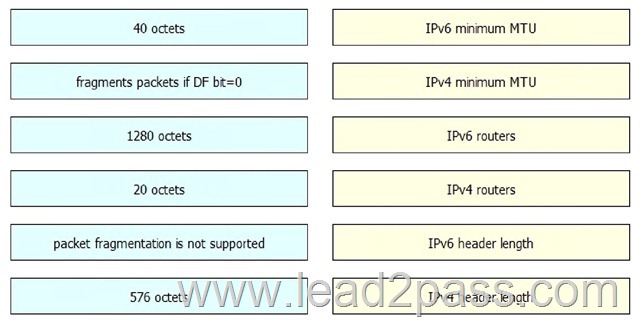
Answer: 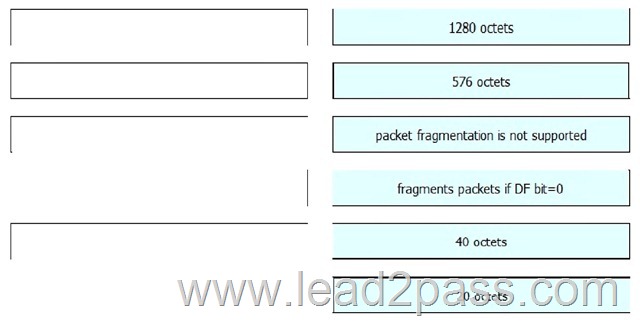
QUESTION 577
Drag and Drop Question
Drag and drop the IPv6 multicast feature on the left to its corresponding function on the right. 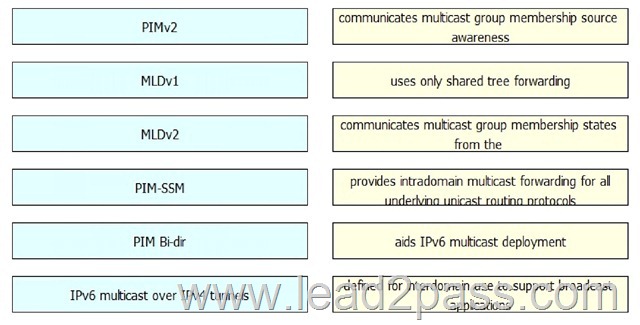
Answer: 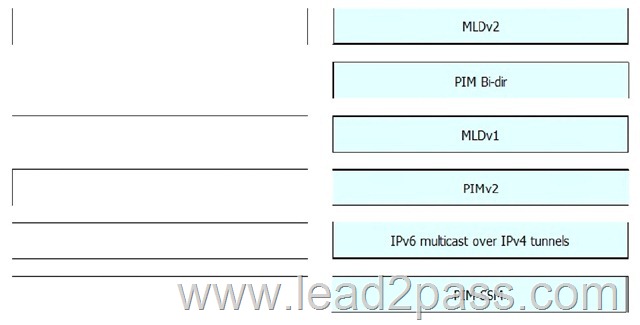
QUESTION 578
Drag and Drop Question
Drag and drop the EIGRP term on the left to the corresponding definition on the right. 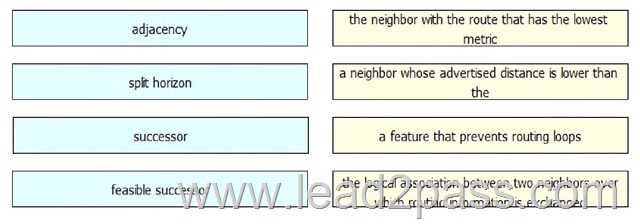
Answer: 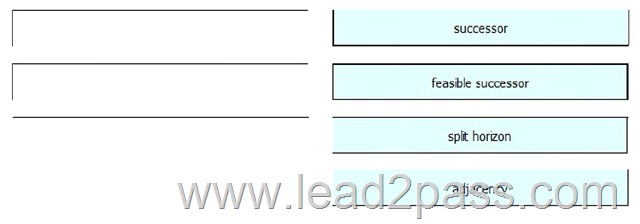
QUESTION 579
Drag and Drop Question
Drag and drop the EIGRP query condition on the left to the corresponding action taken by the router on the right. 
Answer: 
QUESTION 580
Drag and Drop Question
Drag and drop the path-selection criteria on the left into the correct route-selection order on the right, that a router will use when having multiple routes toward the same destination. 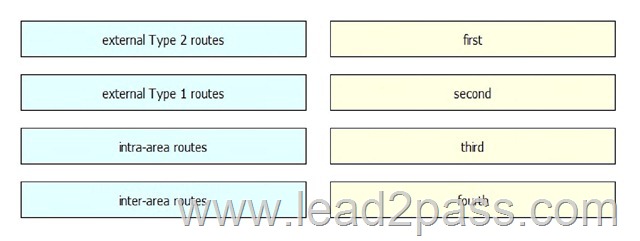
Answer: 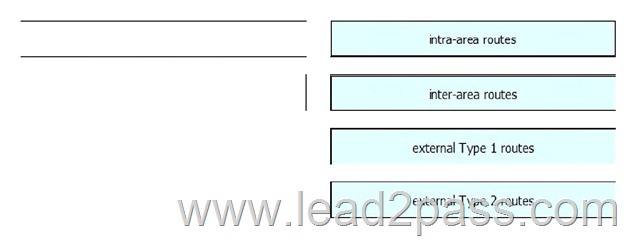
QUESTION 581
Drag and Drop Question
Drag and drop the multiprotocol BGP feature on the left to the corresponding description on the right. 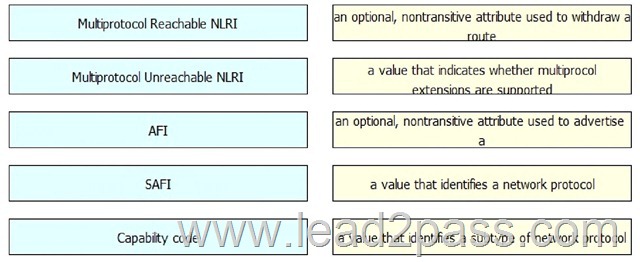
Answer: 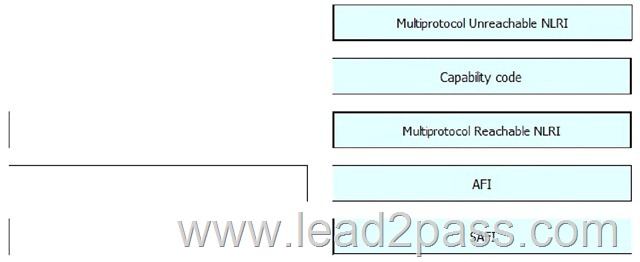
QUESTION 582
Drag and Drop Question
Drag and drop the MPLS term on the left to the function it performs on the right. 
Answer: 
QUESTION 583
Drag and Drop Question
Drag and drop the NHRP flag on the left to the corresponding meaning on the right. 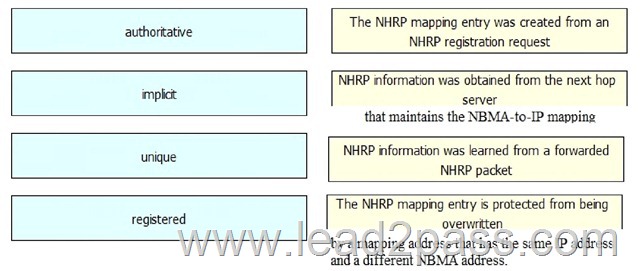
Answer: 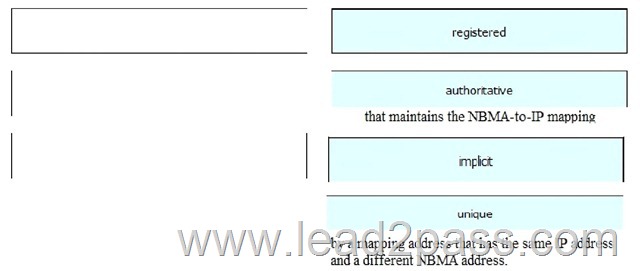
QUESTION 584
Refer to the exhibit. When would the EEM applet be triggered? 
A. every time that the input packet per second counter is below 10,000
B. every time that the input packet per second counter has increased by 1,000
C. every time that the input packet per second counter is above 10,000
D. every time that the input packet per second counter has decreased by 1,000
Answer: C
QUESTION 585
Refer to the exhibit. Based on the above commands, when will the output of the show log command be saved? 
A. Each time the total CPU utilization goes below 50 percent
B. Each time the total CPU utilization goes above 80 percent
C. Every 5 minutes while the total CPU utilization is above 80 percent
D. Every 5 seconds while the total CPU utilization is above 80 percent
E. Every 5 minutes while the total CPU utilization is below 50 percent
F. Every 5 seconds while the total CPU utilization is below 50 percent
Answer: F
Explanation:
he cpu threshold generates syslog messages when it goes above 80 % and when it comes back down below 50% after being above 80%.
It checks cpu utilization every 5 seconds.
When the cpu has been above 80%, and has come back below 50%, the syslog message SYS-1-CPUFALLINGTHRESHOLD is generated
-thats when the “show log” command is triggered
The closest answer is “Each time the total CPU goes below 50 percent”
QUESTION 586
Refer to the exhibit. Which of the following options will trigger the applet? 
A. an external Cisco IOS event
B. a manually run policy event
C. a preconfigured timer
D. an automated RPC call
Answer: B
Explanation:
There are two ways to manually run an EEM policy. EEM usually schedules and runs policies on the basis of an event specification that is contained within the policy itself. The event none command allows EEM to identify an EEM policy that can either be run manually or be run when an EEM applet is triggered. To run the policy, use either the action policy command in applet configuration mode or the event manager run command in global configuration mode.
QUESTION 587
In GLBP, which router will answer on client ARP requests?
A. all active AVF routers as the first response is used by the client
B. the AVG router, replying with a different AVF MAC address each time
C. a random AVF router, based on a GLBP seed hash key
D. only the AVG router that received the ARP request first
Answer: B
Explanation:
LBP Active Virtual Gateway
Members of a GLBP group elect one gateway to be the active virtual gateway (AVG) for that group. Other group members provide backup for the AVG in the event that the AVG becomes unavailable. The AVG assigns a virtual MAC address to each member of the GLBP group. Each gateway assumes responsibility for forwarding packets sent to the virtual MAC address assigned to it by the AVG. These gateways are known as active virtual forwarders (AVFs) for their virtual MAC address. The AVG is responsible for answering Address Resolution Protocol (ARP) requests for the virtual IP address.
Load sharing is achieved by the AVG replying to the ARP requests with different virtual MAC addresses.
http://www.cisco.com/en/US/docs/ios/12_2t/12_2t15/feature/guide/ft_glbp.html#wp1039649
QUESTION 588
Refer to the exhibit. What is true about traffic from the INSIDE zone to the OUTSIDE zone? 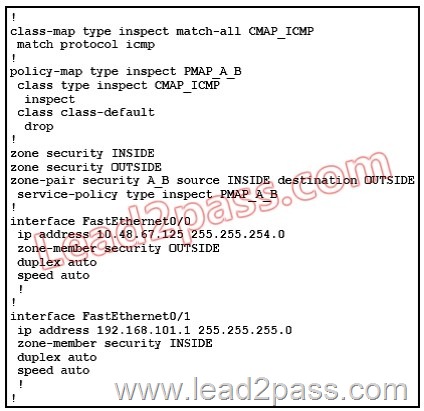
A. All icmp echo requests will be inspected.
B. All IP traffic will be dropped.
C. All icmp echo requests will be passed, but the icmp echo reply to the echo request from the
OUTSIDE zone will be dropped. /..l
D. All IP traffic will be inspected.
Answer: A
Explanation:
When the traffic moves from inside to outside zone, ICMP echo requests will be inspected because the inspection is set using policy-map-type command is used.
QUESTION 589
What is also called Type 0 authentication in OSPF on Cisco Routers?
A. MD5
B. There is no Type 0 authentication
C. SHA1
D. Null
Answer: D
Explanation:
These are the three different types of authentication supported by OSPF. Null Authentication–This is also called Type 0 and it means no authentication information is included in the packet header. It is the default.
Plain Text Authentication–This is also called Type 1 and it uses simple clear-text passwords. MD5 Authentication–This is also called Type 2 and it uses MD5 cryptographic passwords.
QUESTION 590
Refer to the exhibit. Which two statements are correct, when the QoS configuration is applied in an outbound direction on a 10-Mb/s interface? (Choose two.) 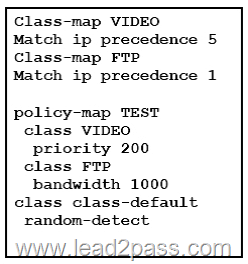
A. When reaching 10 Mb/s of input rate, the video class will be policed to 200 kb/s.
B. The class FTP is allowed to reach more than 1 Mb/s in the event of congestion.
C. IP precedence 1 traffic is affected by a drop probability.
D. Video traffic above 200 kb/s is allowed to pass when the total interface output rate does not
reach 10 Mb/s.
E. Video traffic above 200 kb/s is allowed to pass when congestion is present.
Answer: BD
Explanation:
http://www.cisco.com/en/US/docs/security/asa/asa82/configuration/guide/intrface.html
QUESTION 591
Refer to the exhibit. A user with IP address 10.10.10.200 fails to use Telnet to a switch with IP address 10.10.20.2.
What is most likely the issue? 
A. The switch is not configured with a default gateway.
B. The HTTP server is not enabled on the switch.
C. STP is blocking the connection from switch to router.
D. IP routing is enabled on the switch, but no route pointing back to the client is configured.
E. The switch is configured with an IP address from the wrong subnet.
Answer: D
Explanation:
As you can see in the exhibit that IP routing is enabled on the switch but no route is pointing back to the client. The ip address of interface vlan 1 is given but after that nothing!
QUESTION 592
Refer to the exhibit. Router RTB is performing one-way redistribution from RIP to OSPF. Which outgoing interface will router RTD choose for packets to the 192.168.0.0/24 network, and why? 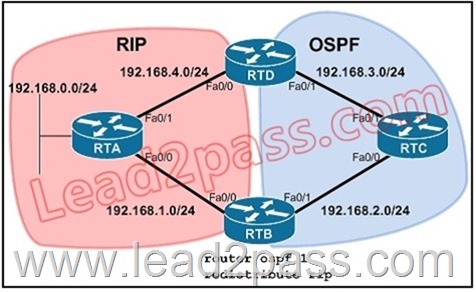
A. Fa0/1, because OSPF is a link-state routing protocol
B. Fa0/0, because RIP is a distance vector protocol
C. Fa0/0, because RIP has a higher administrative distance
D. Fa0/0, because OSPF has a lower administrative distance
E. Fa0/1, because OSPF has a lower administrative distance
F. Fa0/1, because RIP has a lower administrative distance
Answer: E
QUESTION 593
Refer to the exhibit. What is the potential issue with this configuration? 
A. There is no potential issue; OSPF will work fine in any condition.
B. Sub-optimal routing may occur since there is no area 1 adjacency between the ABRs.
C. This is a wrong OSPF configuration because all routers must be in area 0 only.
D. This is a wrong OSPF configuration because /30 requires 0.0.0.3 wild card.
Answer: B
Explanation:
The primary difference is that the GRE tunnel hides the real recipients under the outer IP header. The “transit” area, in that case, does not need to actually know all the prefixes. What it needs, though, is a default route that points towards the backbone. Suboptimal routing may occur, then, because the traffic from the “transit” area must first reach the backbone in order to get GRE- encapsulated and carried again through the “transit” area to the disconnected area.
QUESTION 594
Refer to the exhibit. What triggered the first SPF recalculation? 
A. changes in a router LSA, subnet LSA, and external LSA
B. changes in a router LSA, summary network LSA, and external LSA
C. changes in a router LSA, summary network LSA, and summary ASBR LSA
D. changes in a router LSA, summary ASBR LSA, and external LSA
Answer: B
Explanation:
OSPFv2 is built around links, and any IP prefix change in an area will trigger a full SPF. It advertises IP information in Router and Network LSAs. The routers thus, advertise both the IP prefix information (or the connected subnet information) and topology information in the same LSAs. This implies that if an IP address attached to an interface changes, OSPF routers would have to originate a Router LSA or a Network LSA, which btw also carries the topology information. This would trigger a full SPF on all routers in that area, since the same LSAs are flooded to convey topological change information. This can be an issue with an access router or the one sitting at the edge, since many stub links can change regularly.
Only changes in interarea, external and NSSA routes result in partial SPF calculation (since type 3, 4, 5 and 7 LSAs only advertise IP prefix information) and thus IS-IS’s PRC is more pervasive than OSPF’s partial SPF.
This difference allows IS-IS to be more tolerant of larger single area domains whereas OSPF forces hierarchical designs for relatively smaller networks. However with the route leaking from L2 to L1 incorporated into IS-IS the apparent motivation for keeping large single area domains too goes away. SPF is calculated in three phases. The first is the calculation of intra-area routes by building the shortest path tree for each attached area. The second phase calculates the inter-area routes by examining the summary LSAs and the last one examines the AS-External-LSAs to calculate the routes to the external destinations.
QUESTION 595
Which two orders in the BGP Best Path Selection process are correct? (Choose two.)
A. Higher local preference, then lowest MED, then eBGP over iBGP paths
B. Higher local preference, then highest weight, then lowest router ID
C. Highest weight, then higher local preference, then shortest AS path
D. Lowest origin type, then higher local preference, then lowest router ID
E. Highest weight, then higher local preference, then highest MED
Answer: AC
Explanation:
Weight is the first attribute BGP uses in the route selection process. Route with a higher weight is preferred when multiple routes exist to the same destination.
QUESTION 596
Refer to the exhibit. How will traffic be split between the routers, assuming that there are many hosts on this subnet? 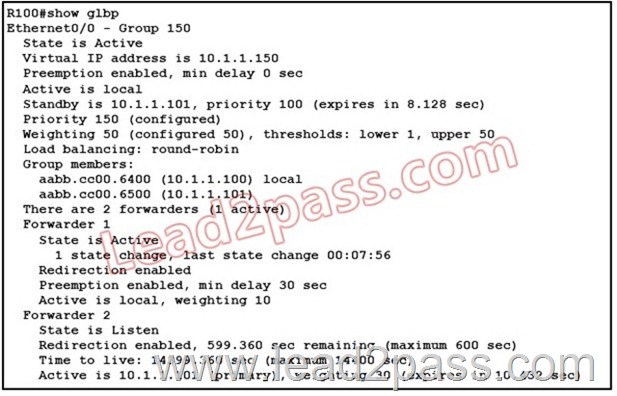
A. All traffic will be sent to the primary router (10.1.1.100).
B. Traffic will be split equally between the two routers (10.1.1.100 and 10.1.1.101).
C. Traffic will be split 25% (10.1.1.101) / 75% (10.1.1.100) between the two routers.
D. Traffic will be split 75% (10.1.1.101) / 25% (10.1.1.100) between the two routers.
Answer: D
QUESTION 597
Refer to the exhibit. A packet from RTD with destination RTG, is reaching RTB. What is the path this packet will take from RTB to reach RTG? 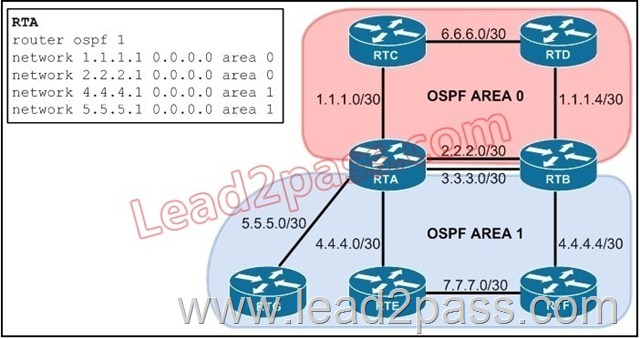
A. RTB – RTA – RTG
B. RTB – RTD – RTC – RTA – RTG
C. RTB – RTF – RTE – RTA – RTG
D. RTB will not be able to reach RTG since the OSPF configuration is wrong.
Answer: C
Explanation:
NOTE: I strongly suspect this question is wrong. There is no way to find the destination without additional information. So this is a wrong question. The exhibit doesn’t provide enough information to calculate the path of the packet
QUESTION 598
Refer to the exhibit. Which path is selected as best path? 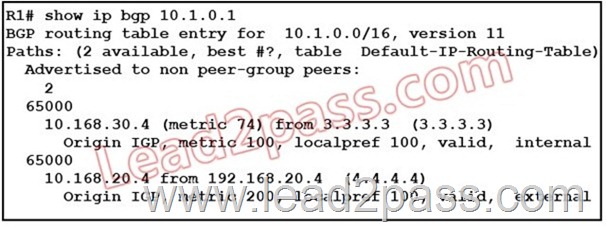
A. path 1, because it is learned from IGP
B. path 1, because the metric is the lowest
C. path 2, because it is external
D. path 2, because it has the higher router ID
Answer: B
Explanation:
Metrics is a property of a route in computer networking, consisting of any value used by a routing protocol to determine whether one particular route should be chosen over another. The routing table stores only the best possible routes, while link-state or topological databases may store all other information as well. For example, Routing Information Protocol uses hopcount (number of hops) to determine the best possible route. The route will go in the direction of the gateway with the lowest metric (default gateway).
QUESTION 599
What is the first thing that happens when IPv6 is enabled on an interface on a host?
A. A router solicitation is sent on that interface.
B. There is a duplicate address detection on the host interface.
C. The link local address is assigned on the host interface.
D. A neighbor redirect message is sent on the host interface.
Answer: B
Explanation:
Duplicate address detection (DAD) is used to verify that an IPv6 home address is unique on the LAN before assigning the address to a physical interface (for example, QDIO).
z/OS Communications Server responds to other nodes doing DAD for IP addresses assigned to the interface.
QUESTION 600
What is the flooding scope of an OSPFv3 LSA, if the value of the S2 bit is set to 1 and the S1 bit is set to 0?
A. link local
B. area wide
C. AS wide
D. reserved
Answer: C
I think Lead2pass dumps are very good for the people who do not have much time for their Cisco 400-101 exam preparation. You can easily pass the exam only by memorize Lead2pass exam questions. Believe or not, I did so and I passed my 400-101 exam.
400-101 new questions on Google Drive: https://drive.google.com/open?id=0B3Syig5i8gpDU2RjeUlHTTZXb1U
2016 Cisco 400-101 exam dumps (All 1219 Q&As) from Lead2pass:
http://www.lead2pass.com/400-101.html [100% Exam Pass Guaranteed]